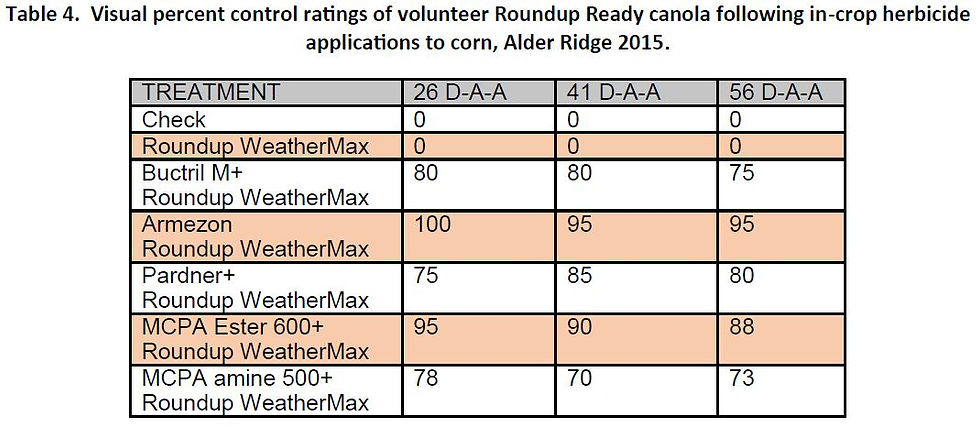Managing Roundup Ready Canola in Corn
- PCBFA

- Jan 16, 2020
- 4 min read
Updated: Jun 26, 2023
Calvin Yoder (1), Akim Omokanye (2), Kim Schoorlemmer (3)
1 Alberta Agriculture and Forestry, Spirit River, AB
2. Peace Country Beef and Forage Association, Fairview, AB
3. DuPont Pioneer, Rycroft, AB
From: Peace Country Beef & Forage Association 2015 Annual Report
Introduction
Corn acreage in the Peace River Region for livestock feed has steadily increased over the past number of years. Most of the corn seeded is Roundup Ready (RR) which provides a good system for controlling weeds. Volunteer RR canola is also a common weed on fields where corn is grown. Managing volunteer RR canola in RR corn requires a broadleaved herbicide that can be mixed with glyphosate and be safely applied prior to seeding corn or applied in-crop.
Selecting a corn herbicide should be based on weeds present, crop stage, crop tolerance and price. There are a number of broadleaved herbicides that can be tank mixed with glyphosate and used on corn as pre seed or in-crop applications. Tank mixing a broadleaved herbicide with glyphosate will improve control of a number of weeds including volunteer RR canola. Herbicides that can be tank mixed with glyphosate and applied prior to seeding corn are Heat, Pardner, Conquor, MCPA and 2,4-D. Some herbicides that are registered on corn and can be tank mixed with glyphosate include Pardner, Buctril M, 2,4-D, MCPA, Banvel and a new herbicide Armezon. Although Banvel, 2,4-D, MCPA are registered for use on corn agronomists prefer not to recommend them as they can cause stunted growth and poor brace root development resulting in lower yields. Bromoxynil which is the main active ingredient of Pardner and tends to be safer although can cause some leaf burn.

Methods
Two trials were conducted in 2015 to evaluate several herbicide tank mixes with Roundup WeatherMax to control volunteer RR canola in field corn. One trial compared several treatments applied prior to seeding (Table 1) corn and the second trial compared treatments applied in-crop (Table 2). All treatments included in the trials are registered for use on corn. Experimental design for the Pre-Seed Herbicide trial was a randomized complete block design with three replications and plots were 2m x 7m in size. Experimental design for the In-Crop Herbicide trial was a randomized complete block design with 2 replicates. Herbicides were applied with a hand held plot sprayer, calibrated to deliver 100 l/ha of water at 270 kPa.
Pre-seed Herbicide Applications
The trial was conducted on a RR canola stubble field near Debolt. The site had uniform populations of volunteer RR canola. Herbicide treatments (Table 1) were applied on May 25th when the canola was at the 1-3 leaf stage. Corn was direct seeded into stubble through the trial area several days following the pre-seed herbicide applications. Visual weed control ratings (percent control) were conducted 22 and 35 days after application (DAA). No crop tolerance data was collected.

In-Crop Corn Herbicide Applications
This trial was conducted on a field of RR corn along Alder Ridge Rd. that had been seeded to corn for a number of years but continued to have issues with volunteer RR canola. The trial area had uniform weed populations of volunteer RR canola, wild buckwheat and lamb’s-quarters. Herbicide treatments (Table 2) were applied on June 17th when the corn was in the 5-6 leaf stage. Volunteer canola was in the 3-6 leaf stage, lamb’s-quarters 3-4 leaf stage and wild buckwheat at the 3-6 leaf stage. Visual weed control ratings (percent control) were conducted 26 and 41 and 56 days after application (D-A-A). No crop tolerance data was collected.

Results and Discussion
Pre-seed Herbicide Applications
Percent visual volunteer RR canola control following several pre-seed herbicide applications are shown on Table 3.

All pre-seed herbicide applications with the exception of Roundup WeatherMax provided excellent control of volunteer RR canola plants that were emerged at the time the herbicides were applied. Heat+Roundup WeatherMax and MCPA ester+Roundup WeatherMax provided some residual control of volunteer canola that was germinating after the application. Pardner and Conquer tank-mixed with Roundup WeatherMax provided excellent control of emerged canola but did not provide any residual activity.
In-Crop Corn Herbicide Applications
Tables 4, 5 and 6 show control of volunteer RR canola, wild buckwheat and lambs’ -quarters following the application of several herbicide treatments applied in-crop on corn.

Table 5. Visual percent control ratings of wild buckwheat following in-crop herbicide applications to corn, Alder Ridge 2015.

Table 6. Visual percent control ratings of lambs’- quarters following in-crop herbicide applications to corn, Alder Ridge 2015.

The addition of a broad-leaved herbicide to Roundup WeatherMax improved control of all volunteer RR canola, lambs’ quarters and wild buckwheat over RU WeatherMax alone particularly on RR canola. Armezon+Roundup WeatherMax showed excellent control of all three weeds. The control of wild buckwheat with Aremezon+Roundup WeatherMax was surprising as wild buckwheat is not on the Armezon label. MCPA ester+Roundup WeatherMax also showed excellent control of RR canola. Bucril M or Pardner tank mixed with Roundup provided satisfactory control of RR canola. MCPA ester+Roundup WeatherMax provided slightly better control on all three weeds than MCPA amine+Roundup WeatherMax. Buctril M and Pardner tank mixed with Roundup WeatherMax provided satisfactory lambs’ quarters and wild buckwheat.





Comments